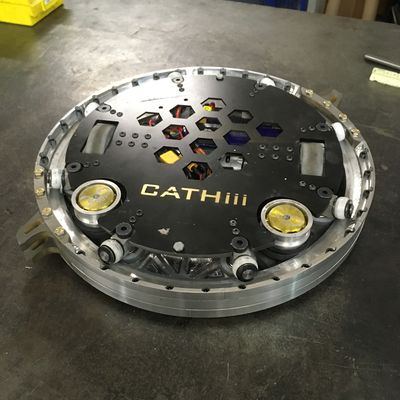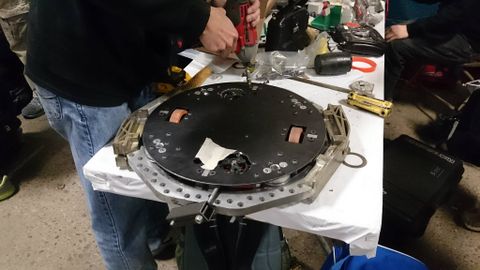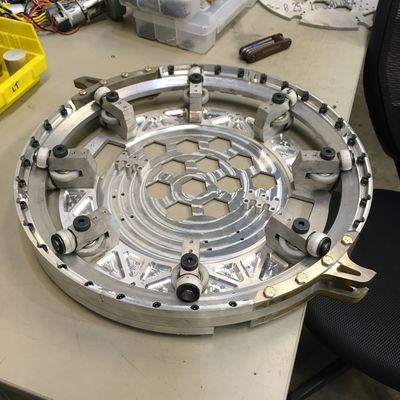Cathi
| Cathi | |
|---|---|
| Year Of Creation | 2013-2014 |
| Version | |
| Current Version | 2.1 |
| Update Year | 2014-2015 |
| Information and Statistics | |
| Weight Class | FeatherWeight |
| Weapon Class | Ring Spinner |
| Wins/Losses | 2/2 |
Cathii is a 30 pound invertable ring spinner robot. A ring spinner design was chosen because it allows and offense on every side of the robot, while still being invertable. The ring design allows weight normally dedicated to the armor of the robot to be dedicated to the weapon, thus increased the power of the weapon. Her ring is approximately 10 pounds and spins around 1500rpm at top speed. Cathii has be undergoing continual improvements every year since her first competition in 2014.
Contents
Competitions
Motorama 2014
- Results:
- Bracket Style:
Motorama 2015
- Results:
- Bracket Style:
- Results:
- Bracket Style:
- Loss in Featherweight Rumble
Motorama 2016
- Results:
Motorama 2017
- Results:
- Bracket Style:
- Win vs Gracious Pipefessionalism
- Loss vs
- Loss vs
- Bracket Style:
Motorama 2018
- Results
- Bracket Style
- Loss vs Marathon
- Win vs
- Win vs
- Loss vs
- Bracket Style
Versions
Cathi V1.0
Desgined By: Max Carlson
Cathi was first designed and built during the 2013-2014 school year.
| Drive Motors | RS-545 |
| Drive Motor Controllers |
Ragebridge 1.0 |
| Weapon Motor |
NTM 5050 |
| Weapon Motor Controllers | TURNIGY K-Force 120A-HV OPTO |
| Reciever | Turnigy |
| Remote Control | Turnigy |
| Battery | Turnigy Nanotech 8s 5000mAh |
Problems:
- Drive Motors are over volted
- Weapon ESCs burned up
- Weapon Belts would bind and stall out the weapon motors
- Overall weight was heavier than the estimated weight(weapon aluminum inserts were removed to account for this)
Future Changes/Improvements:
- Decrease the main robot voltage
- Look into new weapon ESCs
- Redesign weapon motor system
- Use more powerful drive motors
Cathi V1.1
Very little changes occured in this second iteration. The majority of parts were reused, with some being altered.
| Drive Motors | RS 550 |
| Drive Motor Controllers |
RageBridge 1.0 |
| Weapon Motor |
NTM 5050 |
| Weapon Motor Controllers | TURNIGY K-Force 120A-HV OPTO |
| Reciever | Turnigy |
| Remote Control | Turnigy |
| Battery | Turnigy Nanotech 6s 5000mAh |
Problems:
- The RS-550s performed better than the RS-545s, but still burnt up
- The Weapon motor controllers continued to burn up
- The inner pulley diameters were decreased to keep the belts from binding. This resulted in under tensioned belts which failed to transmit the force of the motors.
Future Changes/Improvements:
- Program the Ragebridge/Tranmitter to limit the motor voltage
- Use new weapon motor controllers
- Change the weapon motor system
- Change the weapon mount system
Cathi V2.1
Designed By: Ethan Bisgaard
Cathii was completely redesigned from the ground up. Some of the design goals were reducing the overall weight and accomplishing that overall weight, redesigning the weapon system, and improving the electronics system. When fininshed, the entire robot shrunk by approximetly 1" in diameter and was estimated to be 28 pounds. The actual weight ended up being 29 pounds accomplishing our first goal. For the weapon system, the weapons mounts were completly redesigned, and we switched to a teardrop wheel drive instead of a beld drive. The new weapon mounts are a custom built tapered roller mount which increased the load ratings, while eliminating the friction seen in the previous pulley design. The idea behind the teardrop wheel is similar to a centrifugal clutch; as the weapons spin up, the wheel would expand to contact the inside face of the weapon ring. Both of these designs accomplished our second goal. Finally, we changed the electronics of the robot. For the drive system, we programed the drive controls on the trasmitter for a maximum voltage of 16 volts instead of the max volts of our robot(22 volts). This kept our drive motors from overvolting and burning up. We also used a new weapon ESC, the Toro TS 150a.
Cathii accomplished all design goals set out. All aspects of the robot worked as expected except for the teardrop wheels.
| Drive Motors | RS-550 |
| Drive Motor Controllers |
RageBridge 1.0 |
| Weapon Motor |
NTM 50-50 |
| Weapon Motor Controllers | Toro TS 150a |
| Reciever | Hobbyking |
| Remote Control | Hobbyking |
| Battery | Turnigy Nanotech 6s 5000mAh |
Problems:
- Teardrop wheels exploded under their high speeds and high forces
- The weapon motors burned up either due to high lateral forces on the motor, or prolongedhigh current in the motor.
Future Changes/Improvements:
- Redesign the weapon drive system
Cathi V2.2
Designed By: Justin Ma
Cathiii was modified from the remnants of V2.1. The weapon ring and tapered roller mounts were retained, while the weapon drive was converted back to a pulley system with a rubber drive wheel. The robot ended up being 28 pounds. For the weapon drive, the pulley system consisted of a steel pulley, angular contact bearings, and aluminum end caps that bolted into both the top and bottom plates, and were driven by two 1/8" wide polyurethane belts. A neoprene rubber wheel, cut from tubing, was epoxied onto the pulley. The drive system was kept the same save for the electronics. The RageBridge was replaced with a Scorpion XXL controller and provided unregulated voltage to the drive system.
| Drive Motors | RS-550 |
| Drive Motor Controllers |
Scorpion XXL |
| Weapon Motor |
Scorpion HKIII-4025-550KV |
| Weapon Motor Controllers | Toro TS 150a |
| Reciever | Hobbyking |
| Remote Control | Hobbyking |
| Battery | Turnigy Nanotech 6S 2650mAh |
Problems:
- Weapon drive wheel detached from the pulley.
- The weapon motors experienced inconsistent loading due to tolerance stack-up of bearings and bearing mounts.
Future Improvements:
- Weapon drive design needs a positive interference mechanism to constrain the weapon drive wheel from slipping off.
- Weapon motor mounts should have a compliance mechanism for radial interference.
Cathi V3.0
Designed By: Dustin Sloan
Basic Design
Cathiii was redesigned again from the ground up. This version involved a complete redesign of the roller mounts. There were 8 roller mounts, each had 3 plastic rollers that had bearings press fit into them. This allowed the ring to be supported radially and axially on separate sets of bearings such that if one failed, the ring could continue to spin without seizing. The ring could be spun freely with little to no resistance. The weapon drive was 2 brushless outrunner motors with aluminum hubs press fit over them. These hubs had 95A durometer polyurethane tires superglued on to contact the ring. The hardness of the tires was critical, as softer tires (80A) were too difficult to machine accurately, and would come off the hubs when the motor spun up from centrifugal forces. The motors were mounted on custom linear rails, with springs to ensure constant contact with the ring. The spring strength could be tuned by tightening a screw, allowing the slippage between the tire and the ring to be adjusted such that suddenly stopping the spinning ring did not burn out the motors. Occasionally the superglue that held the tires to the hubs would fail, which was why it was important to have 2 weapon motors that could drive the ring on their own if the other motor failed. This proved useful in a match. The drive used dc brushed motors, Banebots gearboxes, Coleson wheels, and a Roboclaw 2x45A ESC.
Performance
This was the first version of Cathiii to have a successful working weapon. There were no fires or electronic failures on this version. The ring could spin up repeatably for over 3 minutes, and effectively deliver powerful hits with no damage to the ring. This version competed in Motorama 2018 with a good deal of success, 2 wins and 2 losses. The was fully working for 3/4 of the matches, and reliably would spin up to 1200RPM. When the ring took direct hit from high energy spinners, the plastic rollers would shatter at the supports closest to the hit location. This was by design, as the ring had enough other rollers to continue spinning. The bolted on aluminum armor also protected the main ring from direct hits. Most matches required replacing a third of the rollers afterwards as well as the aluminum armor. In Cathiii's 3rd fight against a large vertical spinner, the ring was hit hard enough by the enemy weapon to deform it into an oval, preventing it from spinning for the rest of the competition. A weapon motor also took a direct hit and was destroyed.
| Drive Motors | RS-550 |
| Drive Motor Controllers | Roboclaw 2X45A |
| Weapon Motor | Scorpion HKIII-4025-550KV |
| Weapon Motor Controllers | 90A YEP |
| Receiver | HobbyKing |
| Remote Control | HobbyKing |
| Battery | Turnigy Nanotech 6S 5000mAh
Turnigy Nanotech 3S 2200mAh |
What Went Well
- Ring spun up to 1200RPM consistently
- Could deliver hits and immediately spin up again
- Ablative plastic rollers deformed/shattered when hit (by design)
- Linear motor slider with adjustment springs was very robust
- Bearing Supports worked well
- Only failed under direct hit
- 2 weapon motor redundancy
- Polyurethane weapon drive wheels did not wear down, (95A durometer)
- Superglue used to hold weapon tire to aluminum hub held up
- It did come off after a few matches but seating the tires in a groove would have fixed this
- Drive was powerful
- Coleson wheels were strong
- Electronics didn’t burn, low current draw on both weapon motors and drive motors
- Motors slipped when ring was jammed, didn’t burn up/overdraw current
- Armor protected ring from most hits
What Went Wrong
- Not enough spare rollers to replace after matches
- Rollers need to take hits better, not explode after first hit
- Some weapons missed armor and hit rollers
- Rubber sometimes came off weapon motor hubs
- Threads in ring destroyed when armor and weapon teeth were torn off
- Ring screws sheared (1/4-20)
- Drive motor separated from gearbox twice, threads pulled out of motor
- Lipos almost bursted, sharp edges inside
- Ring deformed after big hits
- Ring was difficult to manufacture (multiple jig setups in haas since it was too large (18in OD))
Improvements
- Ring
- Thicker, less prone to warping
- 7075 AL instead of 6061
- No threading so bolts don’t tear out
- Helicoils?
- Thru bolts with nuts
- Smaller diameter for machining in HAAS, < 15in OD
- Bigger Screws, 5/16-18
- Ring Teeth
- Thicker material around bolts
- Armor
- Thicker, more material around bolt counterbore
- More Spares
- Ring Roller Mounts
- More protected to avoid direct hits
- Better way to fix bearing shafts to mount, press fit would come out from big hits
- Threaded or locking pin
- Easier assembly
- Polyurethane rollers instead of delrin to absorb impact elastically without shattering
- Ring Drive
- Better attach rubber, slot on hub with tapper to ease assembly
- Superglue + slot should be enough
- Drive
- Brushless, more compact and smaller cheaper ESCs
- Everyone else using brushless


